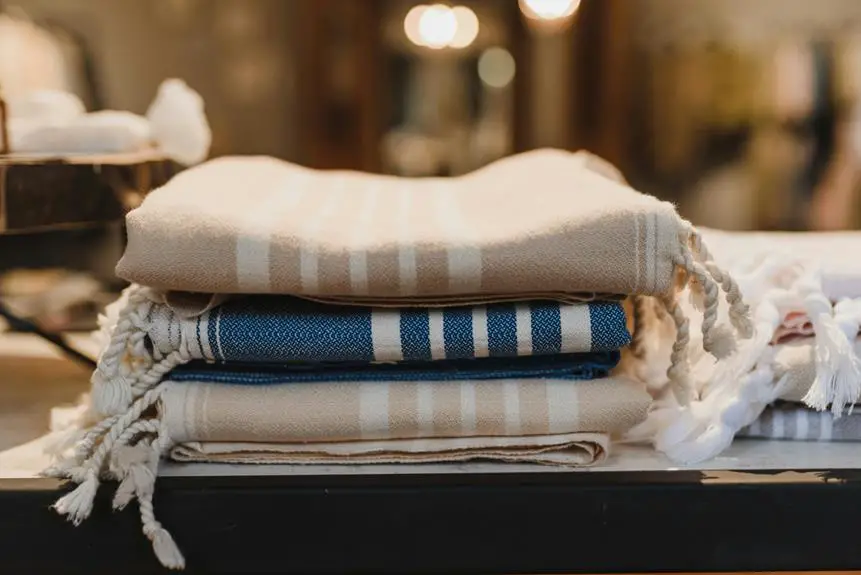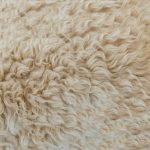You're likely familiar with French terry fabric, but have you ever stopped to think about how well it holds up over time? If you're considering investing in a French terry garment or textile, you'll want to know if it's durable enough to withstand repeated wear and washing. While French terry is known for its looped pile construction and dense weave, which provide excellent durability, it's not immune to wear and tear. In fact, it can be prone to pilling and snagging, which can affect its appearance over time. But just how long can you expect French terry fabric to last?
Table of Contents
What Is French Terry Fabric
French terry fabric is a type of textile that's known for its softness, absorbency, and lightweight properties.
It's made from a specific type of weave that creates a looped pile on one side and a smooth surface on the other. This construction gives French terry its signature texture and functionality.
When you look closely at French terry fabric, you'll notice the loops on the surface. These loops are what make the fabric so absorbent and breathable.
They also contribute to the fabric's softness and flexibility.
French terry fabric can be made from a variety of materials, including cotton, polyester, and blends.
The type of material used can affect the fabric's performance and durability.
Generally, French terry fabric is a popular choice for activewear and loungewear because it's comfortable, easy to care for, and suitable for a range of activities.
Its unique properties make it a great choice for anyone looking for a reliable and cozy fabric.
Durability Factors to Consider
When evaluating the durability of French terry fabric, several factors come into play, including the type of material used, the density of the weave, and how well the fabric is cared for. You'll want to consider these factors when deciding whether French terry fabric is right for your next project.
Here are some key factors to consider:
| Factor | Description | Impact on Durability |
|---|---|---|
| Material | Type of cotton or blend used | Affects strength and resistance to wear |
| Weave Density | Tightness of the fabric's weave | Impacts fabric's ability to withstand stress |
| Care Instructions | How well you follow washing and drying guidelines | Directly affects fabric's lifespan |
As you can see, the type of material used and the density of the weave play a significant role in determining the durability of French terry fabric. By choosing a high-quality material and following proper care instructions, you can help extend the life of your French terry fabric. Additionally, considering the intended use of the fabric will also help you make an informed decision about its durability. By taking these factors into account, you can ensure that your French terry fabric lasts as long as possible.
French Terry Fabric Lifespan
A French terry fabric's lifespan is largely determined by the combination of material quality, weave density, and care instructions that we've discussed, so understanding these factors will help you make an informed prediction about how long your fabric will last.
By considering the type of fibers used, the tightness of the weave, and how you plan to care for the fabric, you can estimate its overall durability.
On average, a well-made French terry fabric can last for several years with proper care.
If you're using a high-quality fabric with a dense weave, you can expect it to withstand repeated washing and wear without significant degradation.
However, if you're using a lower-quality fabric or neglecting to follow care instructions, the lifespan of your French terry fabric may be shorter.
Common Wear and Tear Issues
Now that you understand how to maximize the lifespan of French Terry Fabric, let's turn to some of the wear and tear issues that might occur if proper care is neglected.
Pilling, fraying, and snagging can create small balls or threadbare patches, respectively.
These conditions generally impact aesthetics or expose weaved textiles for worsening appearances.
Will these conditions, which can actually begin to cut through fully with rest, sound very probably giving whole appearances, make you wonder if they are worth concerning yourself with fully?
Maybe those impacts are worth considering, as they can make you wonder if you should follow a certain point, clearly perhaps, and read on to find out why you might have wondered about these conditions in the first place.
Pilling and Fraying
French terry fabric is prone to pilling and fraying, especially in high-wear areas, due to its soft and looped pile construction.
As you wear and wash your French terry garments, the loops can start to break down, causing tiny balls of fiber to form on the surface. This pilling can give the fabric a fuzzy, worn appearance.
Fraying, on the other hand, occurs when the fabric's edges start to unravel, causing a rough, uneven edge to form.
You can take steps to minimize pilling and fraying on your French terry fabrics. Washing your garments inside out and using a gentle cycle can help reduce friction and prevent pilling.
Avoiding fabric softener and bleach can also help preserve the fabric's natural oils and prevent damage.
When it comes to fraying, using a serger or zigzag stitch on your sewing machine can help finish the edges and prevent unraveling.
Snagging and Runs
While pilling and fraying can be frustrating issues with French terry fabric, snagging and runs are another common wear and tear problem that can quickly ruin the appearance of your garments. You may notice that your French terry fabric is prone to snagging, especially if you wear jewelry or have long fingernails. A snag can quickly turn into a run, which can be difficult to repair.
Here are some common scenarios where snagging and runs can occur:
| Scenario | Likelihood of Snagging/Runs |
|---|---|
| Wearing French terry fabric while gardening or engaging in outdoor activities | High |
| Wearing French terry fabric with jewelry or accessories that can catch on the fabric | Medium |
| Washing French terry fabric with other clothes that have zippers or rough seams | Medium |
To minimize the risk of snagging and runs, you can take a few precautions. Avoid wearing French terry fabric while engaging in activities that can cause friction or abrasion. You can also wash your French terry fabric separately from other clothes to reduce the risk of snagging. By taking these precautions, you can help extend the life of your French terry fabric garments.
Care and Maintenance Tips
To keep your French terry fabric looking its best, it's essential to follow a few simple care and maintenance tips that'll help extend its lifespan and prevent damage.
First, you should wash your French terry fabric in cold water using a mild detergent. Avoid using bleach or harsh chemicals, as they can damage the fabric's fibers. When washing, gently turn your garment inside out to prevent pilling or snagging.
When it comes to drying, it's best to air-dry your French terry fabric or tumble dry it on a low heat setting. High heat can cause the fabric to shrink or lose its softness. You should also avoid wringing or twisting your garment, as this can cause stretching or distortion.
Instead, gently remove excess water and lay it flat to dry. Regularly cleaning and maintaining your French terry fabric will help prevent the buildup of dirt and oils that can damage the fabric over time.
Comparing French Terry to Other Fabrics
When you're considering French terry fabric for your next project, you're probably wondering how it stacks up against other popular fabrics. You'll want to compare its characteristics to those of cotton, fleece, and velour to make an informed decision.
Cotton Vs French Terry
Cotton, a popular fabric choice, compares to French terry in terms of performance, durability, and overall quality. When deciding between these two fabrics, it's essential to consider their unique characteristics.
Absorbency: French terry is known for its exceptional absorbency, making it ideal for towels and activewear. Cotton, on the other hand, can also absorb moisture, but not to the same extent.
Softness: Both fabrics are soft to the touch, but French terry has a more plush pile that provides extra comfort.
Durability: French terry is generally more durable than cotton, with a longer lifespan and less prone to wear and tear.
Breathability: Cotton is a natural, breathable fabric, while French terry can be less breathable due to its dense construction.
Shrinkage: Cotton is more prone to shrinkage than French terry, which can affect the fit and size of your garment.
When choosing between cotton and French terry, consider the specific needs of your project. If you need a soft, absorbent, and durable fabric, French terry may be the better choice. However, if you prioritize breathability and a natural look, cotton might be the way to go.
Terry Vs Fleece Fabric
Now that we've weighed the pros and cons of French terry against cotton, let's expand our comparison to another popular fabric: fleece, and explore how French terry stacks up in terms of performance, warmth, and overall value.
You're likely familiar with fleece, known for its softness, warmth, and lightweight properties. While fleece is great for casual wear and athletic apparel, French terry offers more durability and absorbency.
French terry's looped piles provide better moisture-wicking capabilities, making it an excellent choice for activewear or loungewear that requires comfort and dryness.
In contrast, fleece tends to lose its shape and softness over time, whereas French terry maintains its texture and performance even after repeated washing.
Additionally, French terry's breathable properties prevent overheating, making it suitable for a wide range of activities. While fleece is a great insulator, French terry provides a more balanced warmth-to-weight ratio, making it an excellent choice for year-round wear.
Considering the performance, warmth, and value, French terry emerges as a strong competitor to fleece. As you weigh your fabric options, keep in mind the benefits of French terry for your next garment or textile project.
French Terry Vs Velour
Comparing French terry to velour, a fabric known for its plush pile and softness, reveals distinct differences in texture, durability, and performance.
French terry has a soft, absorbent surface with loops on the inside, while velour has a plush pile on the outside and a smooth surface on the inside.
When it comes to durability, French terry is generally more resistant to wear and tear, as its loops can withstand friction and stress. Velour, on the other hand, can be prone to pilling and snagging.
Key differences to consider are as follows.
Texture: French terry has a soft, absorbent surface with loops on the inside, while velour has a plush pile on the outside and a smooth surface on the inside.
Durability: French terry is generally more resistant to wear and tear, while velour can be prone to pilling and snagging.
Breathability: French terry is more breathable than velour, making it a better choice for athletic wear.
Softness: Velour is known for its exceptional softness, but French terry can also be very soft depending on the weave.
Care: French terry is generally easier to care for than velour, as it can be machine washed and dried.
Frequently Asked Questions
Is French Terry Fabric Suitable for Outdoor Clothing?
You're considering French terry fabric for outdoor clothing. It's a great choice for casual wear, but may not be ideal for harsh weather conditions or high-activity outdoor gear. It's best for mild outdoor activities, like hiking or camping in fair weather.
Can French Terry Fabric Be Used for Upholstery?
You're considering French terry fabric for upholstery, but you'll want to weigh its pros and cons. While it's soft and comfortable, it may not be durable enough for heavy use, and its cotton content can shrink or lose shape.
Does French Terry Fabric Have Breathability Issues?
You might worry that French Terry fabric has breathability issues, but its looped pile construction actually allows for airflow and moisture-wicking properties, making it a comfortable choice for clothing and home textiles that require ventilation.
How Does French Terry Fabric Perform in Extreme Temperatures?
You'll find that French terry fabric performs moderately in extreme temperatures. It's not the best choice for freezing cold or scorching hot conditions, but it'll keep you cozy in mild temperatures with a comfortable, soft feel.
Is French Terry Fabric Prone to Pilling or Snagging?
You'll notice that French terry fabric can be prone to pilling or snagging, especially if you're rough on your clothes. However, high-quality French terry is less likely to pill or snag, and it'll last longer.
- How Does Ring Spun Cotton Affect Garment Fit and Shape Retention? - August 13, 2024
- What Are the Challenges in Producing Ring Spun Cotton? - August 13, 2024
- Is Ring Spun Cotton Suitable for Plus-Size Clothing? - August 13, 2024







